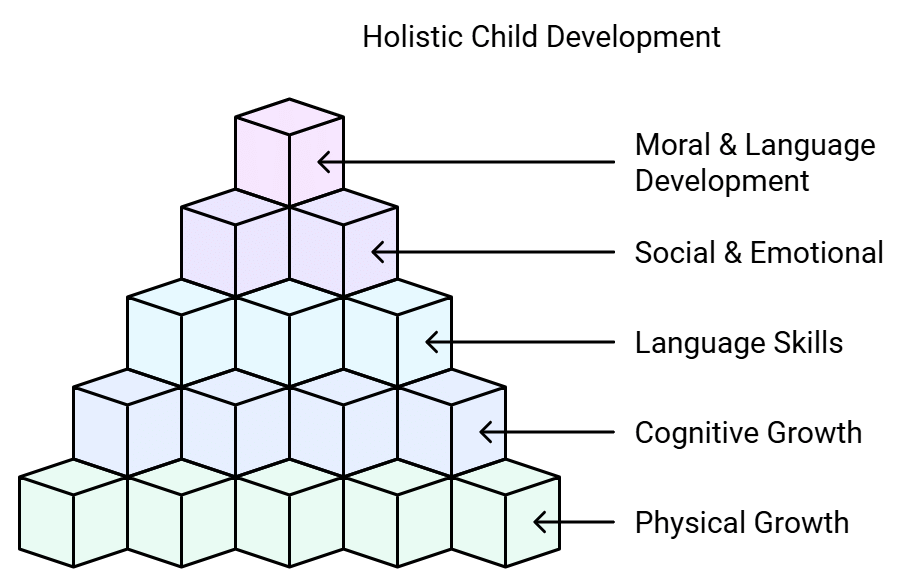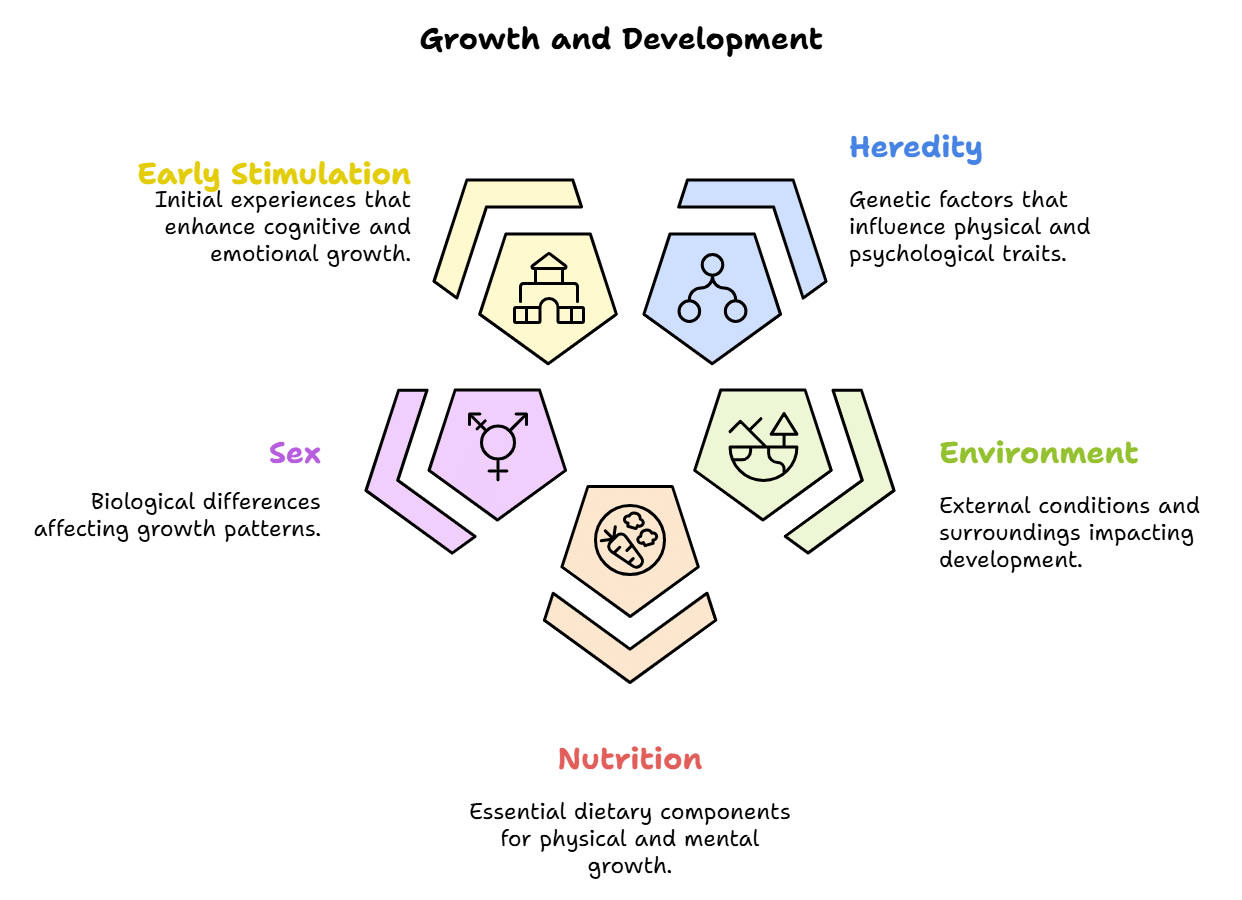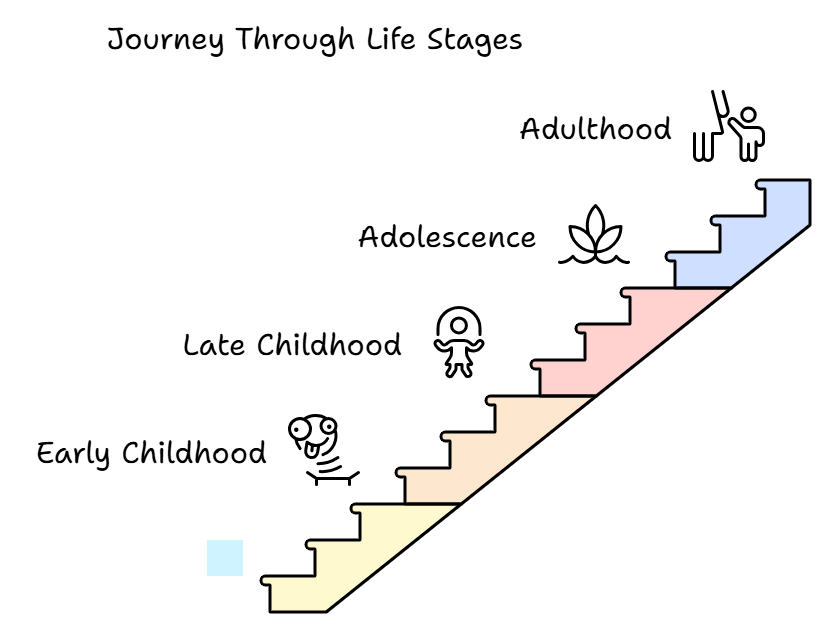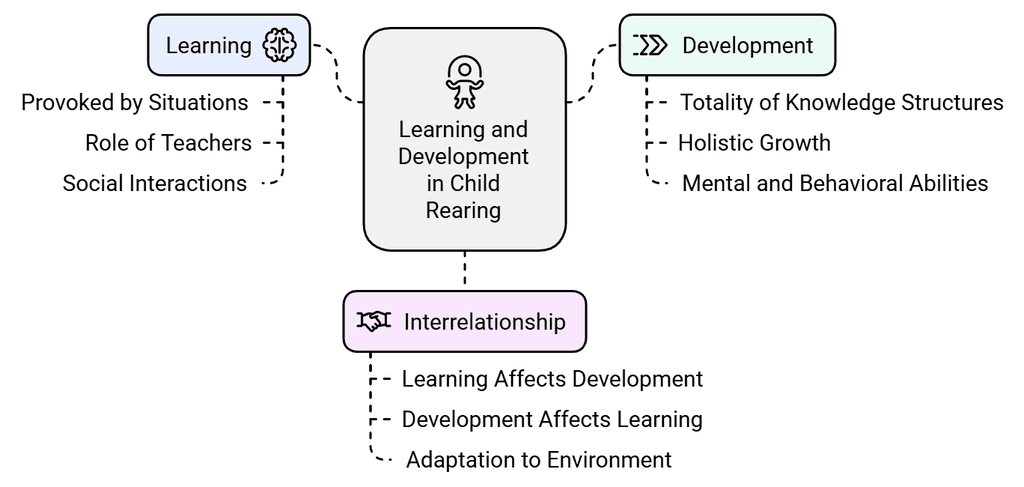Notes: Concept of Development & Its Relationship with Learning | Child Development and Pedagogy for CTET Preparation - CTET & State TET PDF Download
| Table of contents |

|
| Characteristics of Development |

|
| Types of Development |

|
| Factors Responsible for Growth and Development |

|
| Stages of Human Development |

|
| Learning |

|
The term ‘development’ refers to the various qualitative and quantitative changes taking place simultaneously with the changes to growth. Therefore, development may be defined as a progressive series of mannered and coherent changes. The word development indicates the changes related to growth and the moves towards maturity.

In other words, development can be described as growth in physical, mental and emotional state of an individual. In the process of development, new abilities and characteristics get manifested and there is a progressive change in the behaviour of individual.
Definitions of development given by various thinkers are given below
- According to Jersild, Telford and Sawrey, “Development refers to the complex set of process involved in the emergence of a mature functioning organism from fertilised ovum”.
- According to E Hurlock, “Development is not limited to growing layer. Instead, it consists of progressive series of changes towards the goal of maturity”. Due to development, new abilities grow in a man.
- According to JE Anderson, “Development is concerned with growth as well as those changes in behaviour which results from environmental situations”.
- According to Heinz Werner, “Development consists of two processes integration and differentiation”.
Characteristics of Development
Following are the six important characteristics of development
- The process of development continues from the moment of conception until the individual reaches maturity.
- Development occurs in an orderly manner and follows a certain sequence. The following sequence is followed in the process of development in human beings— Infancy— Early childhood— Late childhood— Adolescence— Maturity
- Development is both qualitative and quantitative. As the child grows physically, he also develops the qualitative aspects of his personality. Thus, these two aspects are inseparable.
- Human growth and development is very complex phenomenon. It is affected by a number of factors, e.g. physical intelligence, sex etc.
- It is possible to predict the rate of development by seeing a slow learner and a superior child, but it cannot be predicted accurately.
- Individuals differ from each other in their pattern and rate of development. The individual differences are caused by differences in heredity, endowments and environment influences.
Types of Development

Following are the types of development
- Physical Development: It is the most recognised and observable change in the life of a child. It includes the gross motor skills, such as walking, jumping, catching etc. and the fine motor skills for painting, writing, drawing etc. This development is largely dependent upon the child’s health and nutritional status. This development is also called as maturation.
- Cognitive Development: It focuses on how children learn and process information. As the children grow in age, they can understand their environment by using their senses (such as seeing, listening, touching, smelling and tasting), registering information in their minds and efficiently retrieving it from their memory. This development indicates the development of intelligence.
- Social and Emotional Development: These are indicators of sound social development among children. The seeds of this social behaviour are sown in infancy itself. Young children also enjoy company of their friends. They develop social skills like sharing, cooperation, patience etc in their interaction with peers and others. According to Hurlock, “Social development means acquisition of the ability to have in accordance with social exceptions”.
Emotions are the stimulated or moved state of mind and are excitement or disturbance in feeling of an individual. Emotional development is the ability to control and manage once’s emotions. It is important that children in their early childhood are surrounded by people who are emotionally mature and stable and are able to manage their emotions. - Language Development: Interaction with one another through various methods of communication i.e. writing, speaking, sign, language etc. but above all language is an important medium of communication. Language is a form of communication that uses words and symbols to express thoughts, desires and feelings.
- Moral Development: Moral development deals with the development of ethics or ethical norms, to value the conscience and the ability to judge an act morally. Children cannot make moral judgements until they achieve a certain level of cognitive maturity.
Growth
Growth means the growth of different parts of human body and the ability of those parts to work. The physical growth affects our behaviour and vice-versa. Thus, growth means shape and growth in weight, which includes growth of muscles also. Herbert Sevenson refers physical growth as ‘big and heavy’.
In other words, growth refers to increase in weight, height and changes in body proportions. Growth takes place in the physical aspect only. Growth also refers to quantitative changes e.g. it is possible to measures how tall a child has grown over a specific period of time.
Differences between Growth and Development
There are some differences that can be put forth easily on the basis of their concepts. The differences are as follows

Factors Responsible for Growth and Development

Following are some important factors that directly or indirectly influencing the development and growth.
They are as follows
- Heredity: It is a biological process through which the transmission of physical and social characteristics takes place from parents to off-springs. It generally influences the different aspects of growth and development i.e. height, weight and structure of the body, colour of hair and eyes, intelligence, aptitude and instincts.
- Environment: It plays an important role in growth and development of an individual. It consists of the sum total of physical and psychological aspects of an individual which he receives from his conception. The environment can be controlled to make heredity more favourable for an individual’s growth.
- Nutrition: It is essential for the healthy development of an individual in terms of physical and mental attributes. Growth and development of an individual mainly depend on his food habits and nutrition. The malnutrition has adverse effect on the structural and functional development of an individual or child.
- Sex: It acts as an important factor of growth and development. There is difference in growth and development of boys and girls. The boys are generally taller, courageous than the girls but girls show rapid physical growth in adolescence and excel to the boys.
In general, the body constitution and structural growth of girls are different from that of boys and the functions of boys and girls are also different in nature. - Early Stimulation: Environment encourages the development of the child’s heredity potentials. e.g. talking to a baby or showing a pre-school pictures in story books, encourages his/her interest in learning words and a desire and to learn and to read. A stimulating environment encourages good physical and mental development, while an unstimulating environment causes the child’s development to fall below its potential.
- Child Rearing: Practice Children brought up by permissive parents tend to lack a sense of responsibility, to have poor emotional control and to become under achievers in whatever they undertake. Those brought up by democratic or even firm parents are likely to make better personal and social adjustments.
Stages of Human Development
The process of development continues even after the individual has attained physical maturity (means growth). The individual is continuously changing as he/she interacts with the environment.
The stages of development have been classified into as below
Infancy Stage

- This is the first stage of growth after pre-natal and it comprises ‘new born to 2 years old’.
- According to the Erik Erikson’s Theory, “The infant depends on the parents, especially the mother. The major developmental task in infancy is to learn whether or not other people, especially primary caregivers, regularly satisfy basic needs”.
- The growth is mostly seen as increase in size, shape and weight. The cells become larger in size, the cervical and lumber curvatures of the spine show up as the baby starts to straighten the head and tries to sit and stand.
Childhood Stage

The childhood stage can be simplified into two stages i.e. early childhood and late childhood.
- Early Childhood Stage or Toy Age (2 to 6 years)
- The early childhood is a time of tremendous growth across all areas of development. At this stage, child likes to do work independently and can take care of his/her own body and interact effectively with others. It is a sensitive period of language development.
- In this stage, the child becomes a toddler with a more balanced, adult like appearance. Despite the age of 4 years child has mastered many skills such as sitting, walking, using toilet, using spoon, scribbling and sufficient hand-eye coordination to catch and throw and also communicate with others and solve problems.
- By the age of six, most children demonstrate the fine-motor skills. A child learns to identify members of family and gets involved in his surroundings.
- Late Childhood Stage (6 to 12 years)
- In this, a child refines his skills acquired during the early childhood period and learns new skills as well. At this stage, child gains height and also physical entities such as mass, number and area etc.
- Sigmund Freud’s psychoanalytic theory labeled this stage of life as the latency stage, a time when sexual and aggressive urges are repressed.
- During this stage, children learn the values of their societies. Thus, the primary developmental task of late childhood could be called integration, both in terms of development within the individual and of the individual within the social context.
- The social skills learned through peer and family relationships and children’s increasing ability to participate in meaningful interpersonal communication, provide a necessary foundation for the challenges of adolescence.
- Best friends are important at this stage and the skills gained in these relationships may provide the building blocks for healthy adult relationships.
- Adolescence Stage (12 to 18 years)
- This stage is considered as the period of development and adjustment during the transitional period between childhood and adulthood.
- Adolescence is defined as a culturally constructed period that generally begins as individuals reach sexual maturity and ends when the individual has established an identity as an adult within his/her social context.
- In other words, the primary development task of adolescence is considered as the identity formation.
- Adolescence is an important period for cognitive development as well as it marks a transition in the way in which individuals think and reason about problems and ideas.
- Adolescents are trying on new roles, new ways of thinking and behaving and they are exploring different ideas and values. Erikson addressed this in his framework of life-span development.
- With so many intense experiences, adolescence is also an important time in emotional development. Mood swings are a characteristic of adolescence.
- Adulthood (18 to 65 + years)
For better understanding of adulthood, it can be divided into following stages. These are- Early Adulthood(18 to 20-25 years): This stage is a development bridge between pre-adulthood and young adulthood. This phase is considered as the healthiest time of life. Arnett suggests that early adulthood is the distinct period between 18 to 25 years of age where adolescents become more independent and explore various life possibilities.
- Young Adulthood(25 to 40 years): At this stage, strength and physical performance reach their peak, flexibility may decrease with age throughout adulthood. Young adulthood is filled with and quests for intimate relationships and other major commitments involving career and life goals.
- Mature Adulthood(40 to 65 years): There are some differences in mature adulthood. Some defines it between middle age 45 to 64 years, but Erik Erikson defines it as between 40 to 65 years of age. At this stage, vision of eyes could change and many who did not need corrective lenses or eyeglasses may find that they need them.
- Aging Adulthood(65 + years): Aging adulthood is also called as late adulthood, which is generally considered to begin at the age of 65. In late adulthood, a variety of physiological changes may occur, including some degree of atrophy of the brain and a decrease in the rate of neural processes.
Learning
Learning is a key process in human behaviour. It is defined as “any relative permanent change in behaviour that occurs as a result of practice and experience”.
Definition of learning are given below
According to EL Thorndike, “Learning is a gradual process where the individual will make many attempts to learn”.
According to Crow and Crow, “The learning involves in the acquisition of habits, knowledge and attitudes”.

Relationship between Learning and Development
- Learning and development are important and distinct psychological processes. Development is a process which concerns the totality of the structures of knowledge. On the other hand, learning is provoked by situation or by a teacher or by an external situation.
- Learning awakens the developmental processes through social interactions with peers and teachers in such a way that it would not occur if the child were in isolation.
- Learning affects development and development also affects learning. As a child grows, he learns about his surroundings and interacts with new environment. This helps in learning and developing his mental and behavioural abilities to adjust or survive in his life.
|
67 videos|154 docs|42 tests
|
FAQs on Notes: Concept of Development & Its Relationship with Learning - Child Development and Pedagogy for CTET Preparation - CTET & State TET
| 1. What are the main characteristics of development in human beings? |  |
| 2. What are the different types of development that individuals experience? |  |
| 3. What factors are responsible for growth and development in individuals? |  |
| 4. What are the stages of human development as recognized in psychology? |  |
| 5. How does development relate to learning in the context of education? |  |





















